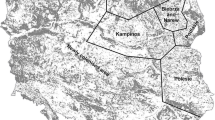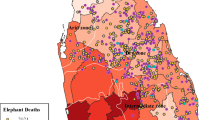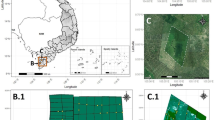Abstract
The eradication of ungulates from offshore islands has now become achievable for island managers, with the size and complexity of an island no longer a major impediment to the desired outcome. Here, we report on a whole-of-island eradication campaign of ungulates (sheep Ovis aries and goats Capra hircus) from the semi-arid Dirk Hartog Island (63,300 ha) off the western Australian coast. The motive behind this campaign was to contribute towards the ecological restoration of this former grazing lease. From 2005, a concerted effort to remove ungulates began with regular destocking, and from 2010 a methodical aerial and ground shooting campaign was undertaken. Long-term commitments of funding and departmental support, staff with diverse skills, and an advisory network of professional people, have been critical components to this large-scale exercise. From 2005 to 2017 a total of 16,318 ungulates (5185 sheep and 11,133 goats) were removed from Dirk Hartog Island: 6839 by mustering, 2422 by ground shooting, 7040 by aerial shooting, and finally 17 by follow-up aerial monitoring and ground shooting. The island was declared free of ungulates in November 2017. To determine the success of the whole-of-island eradication campaign, multiple methods were adopted to locate remaining animals: use of ‘Judas’ goats, monitoring by motion-sensor cameras at water sources and across the island, and recording of tracks and fresh scats to locate any remaining animals. We estimated the likelihood that sheep and goats have been successfully eradicated from the island is 99.9% and 96.9%, respectively. The total cost (AUS$) of the aerial component of the eradication was $1,055,184, an average of $150/goat or $16/ha. The monitoring phase of the campaign (aerial detection and ground shoot) cost the least in terms of actual expenses (approximately $187,000) but the most is terms of cost per remaining goat (approximately $14,400). Ecosystem recovery following the eradication is already apparent with increased vegetation cover and reduced erosion. We conclude with some shared lessons that may assist similar large-scale eradication campaigns of islands. To date, Dirk Hartog Island is the largest island in the world where whole-of-island goat (and sheep) eradication has been achieved.







Similar content being viewed by others
References
Baynes A (1990) The mammals of Shark Bay, Western Australia. In: Berry PF, Bradshaw SD, Wilson BR (eds) Research in Shark Bay—report of the France-Australe Bicentenary Expedition Committee. Western Australian Museum, Perth, pp 313–325
Bode M, Brennan KEC, Helmstedt K, Desmond A, Smia R, Algar D, O’Hara RB (2013) Interior fences can reduce cost and uncertainty when eradicating invasive species from large islands. Methods Ecol Evol 4:819–827
Bunbury N, von Brandis R, Currie JC, van de Crommenacker J, Accouche W, Birch D, Chong-Seng L, Doak N, Haupt P, Haverson P, Jean-Baptiste M, Fleischer-Dogley F (2018) Late stage dynamics of a successful feral goat eradication from the UNESCO World Heritage site of Aldabra Atoll, Seychelles. Biol Inv 20:1735–1747
Campbell K, Donlan CJ (2005) Feral goat eradications on islands. Conserv Biol 19:1362–1374
Campbell K, Donlan CJ, Cruz F, Carrion V (2004) Eradication of feral goats Capra hircus from Pinta Island, Galápagos, Ecuador. ORYX 38:328–333
Carrion V, Donlan CJ, Campbell KJ, Lavoie C, Cruz F (2011) Archipelago wide island restoration in the Galapagos Islands: reducing costs of invasive mammal eradication programs and reinvasion risk. PLoS ONE 6:e18835
Chynoweth MW, Litton CM, Lepczyk CA, Hess SC, Cordell S (2013) Biology and impacts of Pacific Island Invasive Species. 9. Capra hircus, the feral goat (Mammalia: Bovidae). Pac Sci 67:141–156
Coblentz BE (1978) The effects of feral goats (Capra hircus) on island ecosystems. Biol Conserv 13:279–286
Courchamp F, Chapuis JL, Pascal M (2003) Mammal invaders on islands: impact, control, and control impact. Biol Rev 78:347–383
Cruz F, Carrion V, Campbell KJ, Lavoie C, Donlan CJ (2009) Bio-economics of large-scale eradication of feral goats from Santiago Island, Galapagos. J Wildl Manag 73:191–200
Department of Environment and Conservation (DEC) (2008) Shark bay world heritage property strategic plan 2008–2020. Department of Environment and Conservation and Department of the Environment, Water, Heritage and the Arts
Department of Environment and Conservation (DEC) (2011) Dirk Hartog Island national park ecological restoration strategic plan. Department of Environment and Conservation, Perth, Western Australia
Department of Environment and Conservation (DEC) (2013) Dirk Hartog Island National Park Ecological Restoration Project. A plan for the eradication of feral goats (Capra hircus) and sheep (Ovis aries) 2013–2018. Department of Environment and Conservation, Perth, Western Australia
Desender K, Baert L, Maelfait J-P, Verdyck P (1999) Conservation on Volcan Alcedo (Galapagos): terrestrial invertebrates and the impact of introduced feral goats. Biol Conserv 87:303–310
DIISE (2015) The database of Island invasive species eradications, developed by Island conservation, Coastal Conservation Action Laboratory UCSC, IUCN SSC Invasive Species Specialist Group, University of Auckland and Landcare Research New Zealand. http://diise.islandconservation.org
Donlan CJ, Luque GM, Wilcox C (2014) Maximizing return on investment for island restoration and species conservation. Conserv Lett 8:171–179
Farnsworth GL, Pollock KH, Nichols JD, Simons TR, Hines JE, Sauer JR (2002) A removal model for estimating detection probabilities from point-count surveys. Auk 119:414–425
Forsyth DM, Hone J, Parkes JP, Reid GH, Stronge D (2003) Feral goat control in Egmont National Park, New Zealand, and the implications for eradication. Wildl Res 30:437–450
Garcillán PP, Ezcurra E, Vega E (2008) Guadalupe Island: Lost Paradise recovered? overgrazing impact on extinction in a remote oceanic island as estimated through accumulation functions. Biodiv Conserv 17:1613–1625
Genovesi P (2007) Limits and potentialities of eradication as a tool for addressing biological invasions. In: Nentwig W (ed) Biological invasions. Springer, Berlin, pp 385–402
Gizicki ZS, Tamez V, Galanopoulou AP, Avramidis P, Foufopoulos J (2018) Long-term effects of feral goats (Capra hircus) on Mediterranean island communities: results from whole island manipulations. Biol Invasions 20:1537–1552
Hamann O (1979) Regeneration of vegetation on Santa Fé and Pinta Islands, Galápagos, after the eradication of goats. Biol Conserv 15:215–235
King D (1992) Home ranges of feral goats in a pastoral area in Western Australia. Wildl Res 19:643–649
MacKenzie DI (2005) Was it there? dealing with imperfect detection for species presence/absence data. Aust NZ J Stat 47:65–74
Masters P, Markopoulos N, Florance B, Southgate R (2018) The eradication of fallow deer (Dama dama) and feral goats (Capra hircus) from Kangaroo Island, South Australia. Aust J Env Manag 25:86–98
McKenzie NL, Hall N, Muir WP (2000) Non-volant mammals of the southern Carnarvon Basin, Western Australia. Rec W Aust Mus Suppl 61:479–510
Moore JL, Rout TM, Hauser CE, Moro D, Jones M, Wilcox C, Possingham H (2010) Protecting islands from pest invasion: optimal allocation of biosecurity resources between quarantine and surveillance. Biol Conserv 143:1068–1078
Morrison S, Macdonald N, Walker K, Lozier L, Shaw M (2007) Facing the dilemma at eradication’s end: uncertainty of absence and the Lazarus effect. Front Ecol Environ 5:271–276
Ortiz-Alcaraz A, Aguirre-Muñoz A, Méndez-Sánchez F, Ortega-Rubio A (2016) Feral sheep eradication at Socorro Island, Mexico: a mandatory step to ensure ecological restoration. Intersciencia 41:184–189
Parkes JP (1990) Feral goat control in New Zealand. Biol Conserv 54:335–348
Parkes JP, Macdonald N, Leaman G (2002) An attempt to eradicate feral goats from Lord Howe Island. In: Veitch CR, Clout MN (eds) Turning the tide: the eradication of invasive species. IUCN, SSC Invasive Species Specialist Group, Gland, pp 233–239
Parkes JP, Ramsey DSL, Macdonald N, Walker K, McKnight S, Cohen BS, Morrison SA (2010) Rapid eradication of feral pigs (Sus scrofa) from Santa Cruz Island, California. Biol Conserv 143:634–641
Pascoe S, Wilcox C, Donlan CJ (2011) Biodiversity offsets: a cost-effective interim solution to seabird bycatch in fisheries? PLoS ONE 6:e25762
Ramsey DSL, Parkes JP, Will D, Hanson CC, Campbell KJ (2011) Quantifying the success of feral cat eradication, San Nicolas Island, California. NZ J Ecol 35:163–173
Ride WDL, Tyndale-Bicoe CH (1962) Mammals. In: Fraser AJ (ed) The results of an expedition to Bernier and Dorre Islands, Shark Bay W.A. in July 1959, Fauna Bulletin No. 2. Fisheries Department of Western Australia, Perth
SAS Institute Inc. (2011) SAS/STAT 9.3 user’s guide. SAS Institute Inc., Cary
Schofield EK (1989) Effects of introduced plants and animals on island vegetation: examples from the Galapagos Archipelago. Conserv Biol 3:227–238
Seber GAF (1982) The estimation of animal abundance and related parameters. MacMillan, New York
Sharp T (2011) Standard operating procedure GOA005: use of judas goats. Invasive Animals CRC, Perth
St. Clair K, Dunton E, Giudice J (2013) A comparison of models using removal effort to estimate animal abundance. J App Stat 40:527–545
Strategen (2012) Dirk Hartog Island ecological restoration project fire management plan. Report prepared for the Department of Environment and Conservation, Perth
Taylor D, Katahira L (1988) Radio-telemetry as an aid in eradicating remnant feral goats. Wildl Soc Bull 16:297–299
Van Dongen R, Huntley B. (2017) Dirk Hartog Island National Park ecological restoration project: vegetation restoration—remote sensing monitoring program report 2016/2017. Department of Environment and Conservation, Perth
Walker TA (1991) Pisonia Islands of the Great Barrier Reef: Part III. Changes in the vascular flora of Lady Musgrave Island. Atoll Res Bull 350:31–41
Acknowledgements
On behalf of the Department of Biodiversity, Conservation and Attractions, the authors thank Geoff Wardle, former lessee of Dirk Hartog Island, for commencing sheep and goat removal in expectation of Dirk Hartog Island becoming a national park and in allowing the Department early access to his grazing lease to commence ground shooting. We also thank Jock Clough and the Wardle family for allowing their private land on Dirk Hartog Island to be included in the whole-of-island eradication program, and Tory and Kieran Wardle for their hospitality during the aerial shooting operations. We thank Butch Maher for his piloting expertise, and skills in aerial shooting and animal tracking from a helicopter. Aerial shooting was initially made possible through funding from the Australian Government’s Caring for Our Country Program. Ongoing funding was available from the Gorgon Barrow Island Net Conservation Benefits Fund which enabled these eradications to be achieved. The Net Conservation Benefits Advisory Board, Shark Bay District staff and the Dirk Hartog Island Management Committee are thanked for their continued support of this Project. Two anonymous referees provided helpful comments to improve this manuscript, and we thank John Parkes for access to his unpublished database on global island goats and sheep eradications. Finally, we thank Ricky van Dongen for production of the flight path map and access to remote sensing unpublished data related to vegetation recovery.
Author information
Authors and Affiliations
Corresponding author
Additional information
Publisher's Note
Springer Nature remains neutral with regard to jurisdictional claims in published maps and institutional affiliations.
Electronic supplementary material
Rights and permissions
About this article
Cite this article
Heriot, S., Asher, J., Williams, M.R. et al. The eradication of ungulates (sheep and goats) from Dirk Hartog Island, Shark Bay World Heritage Area, Australia. Biol Invasions 21, 1789–1805 (2019). https://doi.org/10.1007/s10530-019-01937-7
Received:
Accepted:
Published:
Issue Date:
DOI: https://doi.org/10.1007/s10530-019-01937-7





